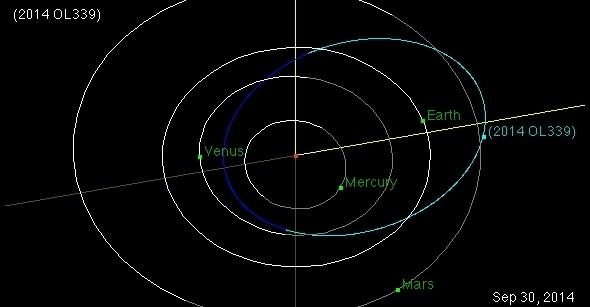MPC designation 2014 OL339 Discovered 29 July 2014 Argument of perihelion 289.6747° Discoverer Farid Char | Discovery date July 29, 2014 Observation arc 381 days (1.04 yr) Inclination 10.18716° Mean anomaly 250.341° | |
 | ||
Aphelion 1.459798 AU (218.3827 Gm) Similar 2003 YN107, 2002 AA29, 3753 Cruithne, (469219) 2016 HO3, 2000 EM26 | ||
Earth s new second moon asteroid 2014 ol339 discovered
2014 OL339 (also written 2014 OL339) is an Aten asteroid that is a temporary quasi-satellite of Earth, the fourth known Earth quasi-satellite.
Contents
- Earth s new second moon asteroid 2014 ol339 discovered
- Discovery
- Orbit and orbital evolution
- Physical properties
- References
Discovery
2014 OL339 was discovered on July 29, 2014 by Farid Char of the Chilean University of Antofagasta. The actual observers were O. Vaduvescu and V. Tudor, observing from the Roque de los Muchachos Observatory for the EURONEAR project with the Isaac Newton Telescope. The intended target of the program was the Apollo asteroid 2013 VQ4 but F. Char identified 2014 OL339 as a streak near the edge of the observed field. As of 14 August 2015, it has been observed 39 times with an observation arc of 381 days.
Orbit and orbital evolution
2014 OL339 is currently an Aten asteroid (Earth-crossing but with a period less than a year). Its semi-major axis (currently 0.9994 AU) is similar to that of Earth (0.9992 AU), but it has a relatively high eccentricity (0.4607) and moderate orbital inclination (10.1910°). Gravitational interaction with Earth causes its orbit to change so that its average period is one year (This means it alternates between being an Aten asteroid and being an Apollo asteroid.) Its mean longitude (around the Sun) is similar to that of Earth, which means that it is fairly close to Earth (less than about 1.5 AU). This makes it a quasi-satellite. It moves in a kidney-shaped path going from east to west relative to Earth ("retrograde", the opposite way from the Moon). The relative mean longitude compared to Earth (that is, its mean longitude minus that of Earth) librates around zero. This means that the center of the "kidney" moves back and forth over a period of years, from being in front of Earth to being behind Earth, but this movement is centered on Earth.
It became a quasi-satellite at least 775 years ago and will stop being that 165 years from now after a "close" encounter with Earth (0.13 AU). This quasi-satellite episode will have had a duration of around a thousand years or more, but less than 2,500 years. Before and after this episode it passes in and out of other types of co-orbital orbits, such as being a trojan or a "passing object" (one whose relative longitude to Earth can attain any value, which is not the case for a quasi-satellite or a Trojan).
Physical properties
With an absolute magnitude of 22.8, it has a diameter in the range 80–180 meters (for an assumed albedo range of 0.04–0.20, respectively).
